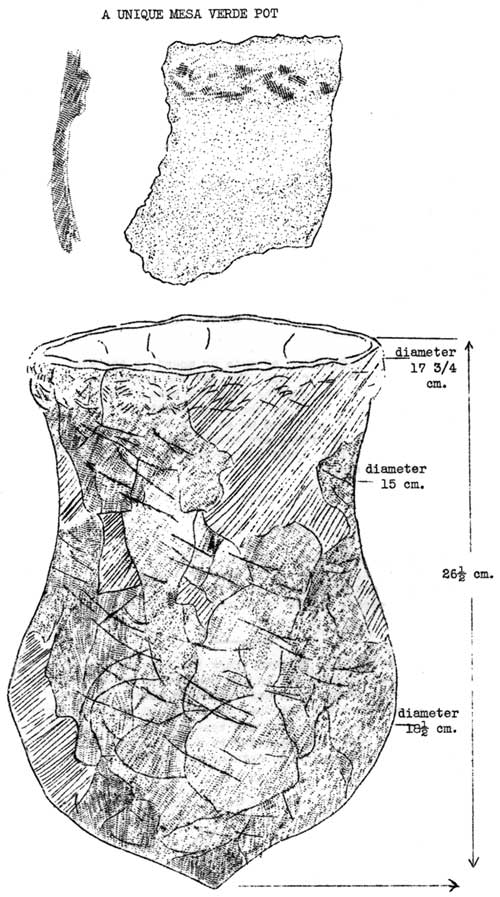A UNIQUE POT FROM MESA VERDE
by
Paul R. Franke
Pottery has been considered a criterion for culture
classification in the Southwest ever since 1915 when Kidder1
and Nelson2 applied it to chronological problems. The pot,
its shape, texture, and decoration, along with a knowledge of its
stratigraphic location, permit a quick recognition of the people who
made it and the approximate period of its manufacture. The ware of Mesa
Verde holds true to this index, and the pottery of the Cliff Dweller can
be distinguished from other southwestern Pueblo ware.
1. Kidder A.V. An introduction to the study of
Southwestern Archaeology. Yale University Press, New Haven, Conn. 1924,
pp 43-46.
2. Nelson, N.C. Chronology of the Tano Ruins N.M., American
Anthropologist n.s. Vol 18, No. 2, pp 159-180 Lancaster,
1916.
The archaeologist is primarily concerned with the
everyday activity of the ancients who once occupied the present ruins,
and the general run of pottery sherds tell a distinct and uniform story
of the ware in use. The unique or bizarre vessels that appear now and
then in ruins or trash-mounds mean little, but are interesting and lead
to much speculation as to their origin.
A most unique group of sherds for this Mesa Verde
region was found on top of the mesa last August, by Earl H. Morris and
the writer. While conducting a short reconnaissance of the high ridge,
lying between Pool and Navaho Canyons, in search of Basket Maker and
Early Pueblo sites, we came upon a scattered mass of sherds. The unusual
rim pieces attracted attention, and we decided to collect them for
laboratory study. Pieces of sherds were found as much as four inches
below the surface, and in trowelling through an area of about four
square yards we collected over two hundred small pieces.
Following the regular treatment and reconstruction a
most unusual shaped vessel resulted. A sampling of the literature,
dealing with this region, fails to record a like vessel. The general
appearance and shape resemble one of the Navaho cooking pots, but the
large size and pointed bottom mark it a stranger. As a whole it reminds
one more of the ware of the Plains Indians than that of the Southwestern
peoples.

(click on image for a PDF version)
No chemical analysis of the clay and tempering
material has been made. The texture is very fine in comparison to Mesa
Verde ware and very much harder. The external color of the pot is
gray-brown, with the inside fire blackened halfway through the walls of
the vessel. This blackened inside of the pot is so hard that
considerable pressure must be exerted for a knife blade to scratch
it.
The surface finish is rough with many criss-cross
indented lines, similar to the impression made by a cord malleating
tool. The rim, outcurving is square and scalloped. The maker further
embellished the vessel by working up a node or ridge one-forth inch
below the lip. This node, one-half inch in width, has a series of thumb
impressions for decoration.
The jar has the bell-like shape of the currogated
southwestern vessels, though higher than wide. Dimensions: Height
26-1/2 centimeters, diameter at lip 17-3/4 centimeters, at the
constricted neck 15 centimeters; and at the expanded bowl it is 18-1/2
centimeters in diameter.
There was no indication of ruin or mound in the
vicinity where the broken pot was found. One had the impression of a
group of strange Indians passing over the mesa. They stopped here to
rest, the pot, part of their equipment was accidently broken, the pieces
to be picked up at this time—no doubt centuries later. Who the
travellers were, from whence they came and where they went, will no
doubt ever remain one of the mysteries of the Mesa Verde.
-oOo-

